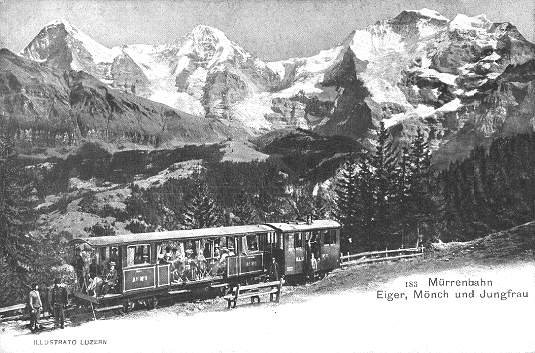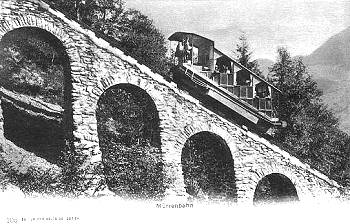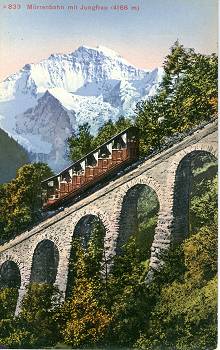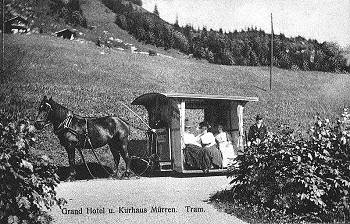

Our postcard above depicts the Mürrenbahn in Switzerland, with the Eiger, Mönch and Jungfrau mountains in the background. This card has an undivided back and is number 183 in a series by Illustrato Luzern. The picture dates from around 1900 and shows locomotive 3 and carriage 1 of the "tramway-like" light railway section of the system, our primary interest. The two smaller views showing the funicular section and are from Photoglob of Zürich, a company that is still producing postcards. The first is their card 105, also dating from around 1900, with the funicular in its water counterbalanced days. The second is card 833 and has the funicular in its electric period around 1910, with the 4166 metre high Jungfrau in the background. Our final small view shows the horse tramway on a postcard published about 1905 by Kunstanstalt Brügger of Meiringen.
The Mürrenbahn, actually called the Bergbahn Lauterbrunnen - Mürren (BLM), is one of the railways that now comes under the management of Jungfraubahnen, who operate five railways and numerous cableways and funiculars in the Bernese Oberland area of central Switzerland. Mürren is a traffic free town on a plateau high above the Lauterbrunnen valley. A concession was granted on 4th July 1887 for the building of the railway in two sections.
 From Lauterbrunnen, a metre gauge funicular worked on the water counterbalance system (right) would take a car up 674 metres (685 after an extension in 1908 to serve a new bottom station building) at a maximum gradient of 606 per thousand, to a station at Grütschalp. This line used three rails, having a common centre rail, and a Riggenbach rack rail for braking. At Grütschalp passengers would change to a metre gauge electric single car train, which would run with slight gradients (max. 50 per thousand) via a station at Winteregg (where today it connects with a chair lift for skiers) to Mürren, a distance of 4.27 km. Power was supplied to the line by a hydro-electric generating station using the water of the Straubach. The line was single track with passing loops at Winteregg and at the termini. The system opened to the public on 14th August 1891, although it was 1917 before a full winter service first ran.
From Lauterbrunnen, a metre gauge funicular worked on the water counterbalance system (right) would take a car up 674 metres (685 after an extension in 1908 to serve a new bottom station building) at a maximum gradient of 606 per thousand, to a station at Grütschalp. This line used three rails, having a common centre rail, and a Riggenbach rack rail for braking. At Grütschalp passengers would change to a metre gauge electric single car train, which would run with slight gradients (max. 50 per thousand) via a station at Winteregg (where today it connects with a chair lift for skiers) to Mürren, a distance of 4.27 km. Power was supplied to the line by a hydro-electric generating station using the water of the Straubach. The line was single track with passing loops at Winteregg and at the termini. The system opened to the public on 14th August 1891, although it was 1917 before a full winter service first ran.
The loco in our main postcard is one of the three (numbered 1-3) two axle units built for the opening of the line in 1891 by Maschenfabrik Oerlikon (MFO). They each had two 25 horsepower 4-pole motors and ran on 525 volts DC supplied by overhead wire and trolley pole. They were always considered underpowered and weighed just 7 tons, so each pulled just one carriage which they ran round at the termini. The speed was fixed at 15 kph. The original wooden carriages, of which there were two, seated 60, plus an additional 26 folding seats. There were also two goods vans as the line did, and still does, carry important supplies to Mürren.
 During the winter of 1901/02 the water counterbalanced funicular was changed to operate on electricity, with new six-compartment cars (left) replacing the original four-compartment stock. This new open-sided stock was enclosed at the end of 1910. The electric winding house was at the top station and used D.C. equipment from Johann Jacob Rieter of Töss, Winterthur. In 1950 the funicular was modernized with new cars and conventional track, the braking then being done by pincer brakes. In 1913 the original rolling stock of the railway section was replaced by self contained units, which themselves were replaced by three modern cars in 1967, which were renewed in 2024.
During the winter of 1901/02 the water counterbalanced funicular was changed to operate on electricity, with new six-compartment cars (left) replacing the original four-compartment stock. This new open-sided stock was enclosed at the end of 1910. The electric winding house was at the top station and used D.C. equipment from Johann Jacob Rieter of Töss, Winterthur. In 1950 the funicular was modernized with new cars and conventional track, the braking then being done by pincer brakes. In 1913 the original rolling stock of the railway section was replaced by self contained units, which themselves were replaced by three modern cars in 1967, which were renewed in 2024.
Throughout the life of the line it has always carried goods. These are taken up to Grütschalp by the funicular, latterly by a flat truck fitted on the uphill end of the cars, and then transferred to the railway on a truck attached to the downhill end of the waiting train. In modern times a clever combination fork lift, turntable and inclined lift at Grütschalp has transferred the pallets of goods. For some years there has been a question of the stability of the ground under the funicular, so during 2006 it was replaced by a large 100 person single (i.e. not counterbalanced) aerial cable car. Goods are now carried on a platform suspended below the cable car, but are transferred in the previous way.
 We cannot leave Mürren without mention of the tiny horse tramway (right). On 10th July 1894 the 455 metres long line opened to connect the BLM station with the Grand Hotel and Kurhaus, the owners of which also owned the tramway. It was originally built in Paris for the World Exhibition in 1889. There were two trams. One was roofed and carried eight people back-to-back on "knifeboard" seats. The second was used for goods. The gauge was 500mm, the narrowest in Switzerland. There was a summer service from 1894 to 1914 and then from 1923 to 1930, carrying a total of around 20,000 passengers. The official closing date is stated as 31st December 1945, but clearly it had not run for many years by then. Some track remained until 1965. The little passenger car has been preserved and has been displayed in the Lucerne Transport Museum and at Mürren station.
We cannot leave Mürren without mention of the tiny horse tramway (right). On 10th July 1894 the 455 metres long line opened to connect the BLM station with the Grand Hotel and Kurhaus, the owners of which also owned the tramway. It was originally built in Paris for the World Exhibition in 1889. There were two trams. One was roofed and carried eight people back-to-back on "knifeboard" seats. The second was used for goods. The gauge was 500mm, the narrowest in Switzerland. There was a summer service from 1894 to 1914 and then from 1923 to 1930, carrying a total of around 20,000 passengers. The official closing date is stated as 31st December 1945, but clearly it had not run for many years by then. Some track remained until 1965. The little passenger car has been preserved and has been displayed in the Lucerne Transport Museum and at Mürren station.
 The mountain scenery viewed from the Mürrenbahn is as stunning now as it was at the date of these postcards, and a visit to the railways in this region is highly recommended.
The mountain scenery viewed from the Mürrenbahn is as stunning now as it was at the date of these postcards, and a visit to the railways in this region is highly recommended.
![]() After this postcard do you fancy a Swiss fondue? Then try the Fond-U-Like fondue website.
After this postcard do you fancy a Swiss fondue? Then try the Fond-U-Like fondue website.
![]() Go to Postcard Of The Month Index
Go to Postcard Of The Month Index